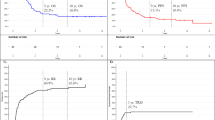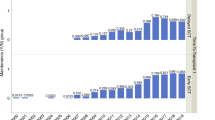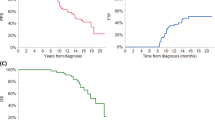Abstract
A single centre series of 195 consecutive newly diagnosed untreated myeloma patients under 70 years, seen between September 1986 and March 1994, were analysed to assess the impact of current intensive treatment methods upon remission rate, response rate and subsequent outcome. They were predominantly an unselected population based group of patients (other than by age) that could be used by purchasers of health care as a model for outcome assessment. All patients were scheduled to receive a care plan which included a sequential package of treatment consisting initially of courses of infusional chemotherapy using vincristine, adriamycin and methyl prednisolone (VAMP) and 90 of these also received cyclophosphamide (C-VAMP). Thirty-eight patients received verapamil in addition to C-VAMP(V-C-VAMP). After VAMP all patients were planned to receive high-dose treatment with melphalan and an autograft (marrow or blood) and 112 received this treatment; a further 29 patients received modified high-dose treatment with melphalan alone (23) or busulfan (6) and 54 (28%) did not proceed to high-dose treatment because of refusal, resistant disease, poor performance or treatment-related death. The patients who received melphalan or busulfan alone instead of high-dose melphalan/autografts did so because of increasing age (P = 0.001) and a raised creatinine (P = 0.05). The complete remission rate was 53% for the whole group and 74% for those receiving high-dose melphalan and an autograft. From July 1988, the sequential therapy package included continuous three times weekly interferon (IFN) after high-dose treatment as maintenance therapy, initially as part of a controlled randomised trial and then for all suitable patients. Fifty-seven patients received IFN. The median overall survival (OS) and progression-free survival (PFS) from first treatment for the whole group of 195 patients is 4.5 years and 25 months, respectively. The 112 patients receiving the melphalan autografts fared significantly better than the rest of the patients with OS and PFS (from high-dose treatment) of 6.6 years and 27 months, respectively (P < 0.005), and the 57 patients also receiving ifn have a os yet to reach a median at 8 years and a pfs of 44 months, significantly better than non ifn high-dose patients (P < 0.0036). however, although we showed benefit for selected patients in studies and trials (particularly with ifn) during the 8-year period of the series, this did not translate into overall pfs benefit in our study for unselected cohorts of patients for 1986–1988 (64 patients) 1989–1992 (100 patients) and 1992–1994 (31 patients) in spite of progressive increases in the proportion of patients receiving ifn (respectively 6, 35 and 58%). this is likely to be due to the dilution of benefit to specific patients by the overall number of patients involved. outcome data from unselected patients are now expected by purchasers and presented in this way, help qualify the activity impact of advances made from research trials for the treatment of population-based cancer problems.
This is a preview of subscription content, access via your institution
Access options
Subscribe to this journal
Receive 12 print issues and online access
$259.00 per year
only $21.58 per issue
Buy this article
- Purchase on Springer Link
- Instant access to full article PDF
Prices may be subject to local taxes which are calculated during checkout
Similar content being viewed by others
Author information
Authors and Affiliations
Rights and permissions
About this article
Cite this article
Powles, R., Raje, N., Milan, S. et al. Outcome assessment of a population-based group of 195 unselected myeloma patients under 70 years of age offered intensive treatment. Bone Marrow Transplant 20, 435–443 (1997). https://doi.org/10.1038/sj.bmt.1700917
Received:
Accepted:
Issue Date:
DOI: https://doi.org/10.1038/sj.bmt.1700917
Keywords
This article is cited by
-
High-dose chemotherapy with autologous stem cell transplantation for multiple myeloma: what predicts the outcome? Experience from a developing country
Bone Marrow Transplantation (2009)
-
Current status of autologous hematopoietic stem cell transplantation in myeloma
Bone Marrow Transplantation (2008)
-
The evolving background for high-dose treatment for myeloma
Bone Marrow Transplantation (2007)
-
Autologous stem cell transplantation is safe and feasible in elderly patients with multiple myeloma
Bone Marrow Transplantation (2007)
-
High-dose chemotherapy and autologous hematopoietic stem cell transplantation in myeloma patients under the age of 65 years
Bone Marrow Transplantation (2007)



